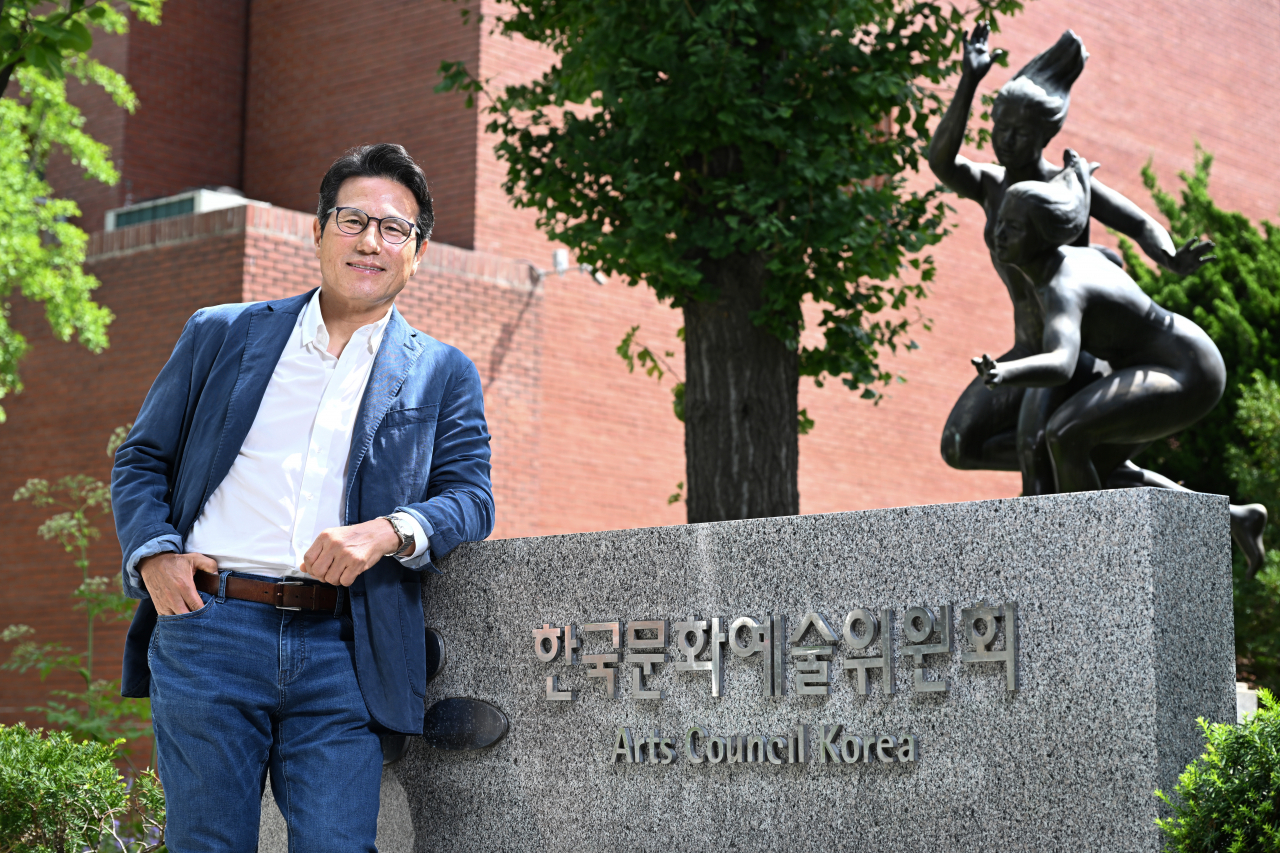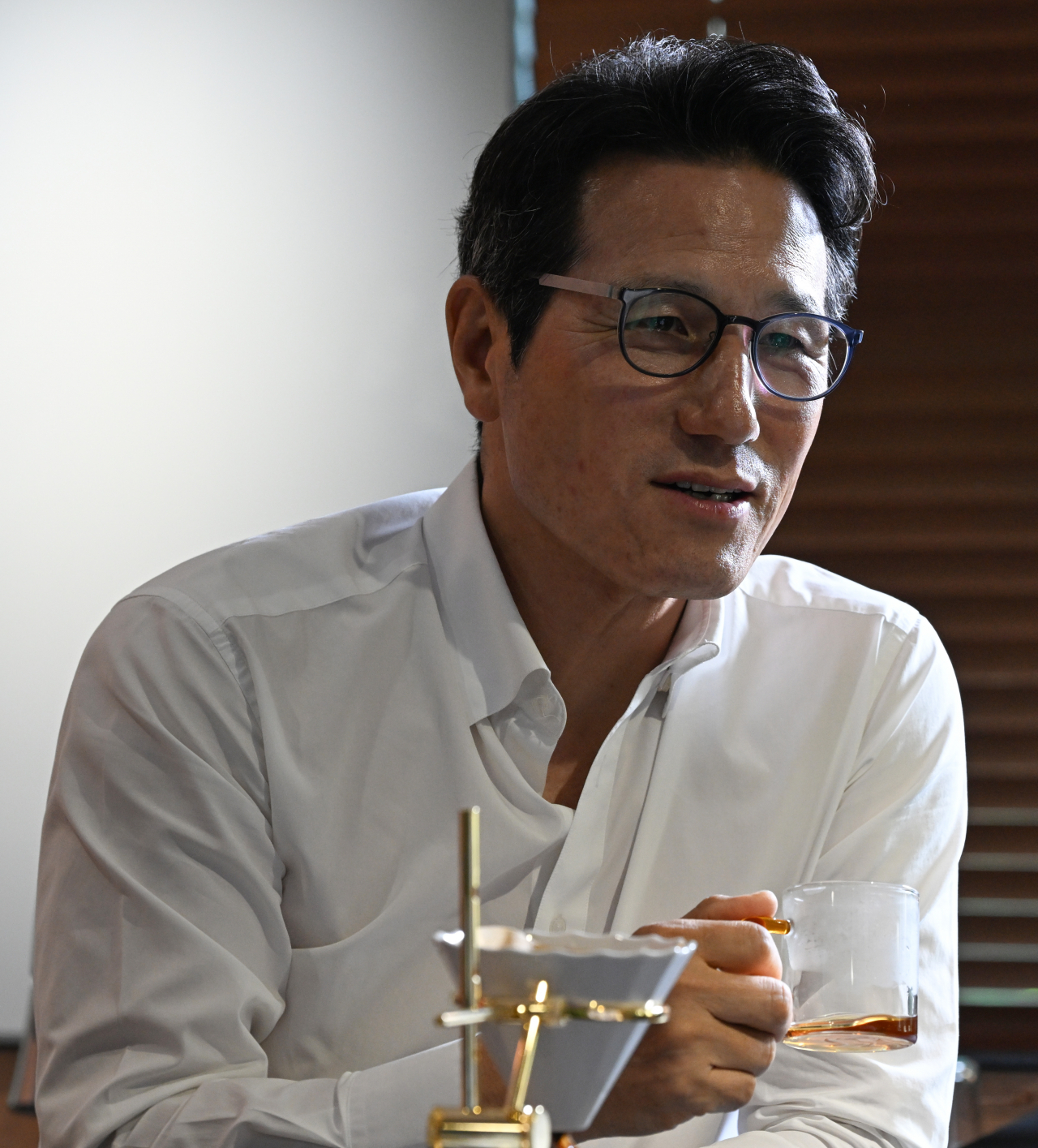[Herald Interview] 'Businesses should be led to invest in the arts': Arts Council Chair Choung Byoung-gug
Expanded Korean Pavilion at Venice Biennale to open next year while exhibition highlighting Paik Nam-june and Korean art of past 30 years will be held at separate venue
By Kim Hoo-ranPublished : Sept. 22, 2023 - 13:59

Wearing a white shirt and jeans, Arts Council Korea Chairperson Choung Byoung-gug prepares coffee at his Seoul office in the small-theater district of Daehagno before the interview in late July.
“Five or six years ago, we signed a memorandum of understanding for a 50 billion-won ($37 million) project to build a coffee museum, a coffee library and so on in Addis Ababa,” said Choung, recalling his work as a member of the National Assembly's Foreign Affairs and Unification Committee. He served five terms in the National Assembly.
“Coffee accounts for 20 percent of GDP. I thought it would be good if the growers could fetch better prices for their beans,” he said. While that project has yet to be executed, Choung continues to brew coffee using beans sourced from Ethiopia.
Having served as culture, sports and tourism minister from January 2011 to September 2011 during the conservative Lee Myung-bak administration, Choung immediately set to work upon his appointment as the chair of the Arts Council Korea, also known as ARKO, in January.
The Arts Council Korea is unique in that it serves two clients -- both the suppliers and the consumers. “Our clients are artists and the public that enjoy the arts,” said Choung. “We need to serve both groups with the scant funds,” he added.
“This year, we were allotted 380 billion won. From this 380 billion won, we issue a 110,000-won voucher, called Munhwa Nuri Card, to some 2.7 million low-income people,” said Choung. The voucher can be used toward cultural activities, sports and travel. On top of some 200 billion won earmarked for the vouchers, another 70 billion won goes toward supporting cultural activities in the provinces. That leaves about 100 billion won for supporting artists.
While about 94 percent of the people eligible for the Munhwa Nuri Card apply and receive the vouchers, their actual usage stands at less than 90 percent, according to Choung. The elderly and people living in remote areas have a hard time getting to cinemas, bookstores or sports facilities where the vouchers can be used, Choung explained.
To rectify the problem, the Arts Council Korea is working on bringing “cultural products” to the people. “We are thinking of cultural product trucks, like food trucks, with young artists going from village to village to put on performances,” he said. The Arts Council Korea would fund the artists, the artists would sell their products and the profit would go to the artists. “We are planning to launch a pilot cultural product truck soon,” he said.

Choung estimates that there are about 150,000 artists in the country, many of whom, especially those working in the pure arts, require outside funding. They are the other clients that the council serves.
Choung acknowledged that practicing the pure arts is not sustainable without support. Almost everyone is looking to the council for support, he said. While the council has several funding projects, only about 24 percent of the applicants end up receiving funding, Choung noted. “That means nearly 80 percent don’t get anything and this is very discouraging for them,” he said.
Attributing the success of K-pop and so-called K-culture to the public and the state’s interest in the arts, he said that investment in the arts was being made even when the country could not really afford it and that is what has made Korea the cultural powerhouse it is today.
“The Arts Council Korea is celebrating its 50th anniversary this year. Fifty years ago, in 1973 when per capita income was a mere $300, when day-to-day living was a struggle and it was difficult for the country to survive without foreign aid, the Arts Council Korea was established, culture and arts promotion act was legislated and collection of culture and arts promotion fund began,” he said.
Unfortunately, politicians and those in power, especially the budgetary authorities, are preoccupied these days with immediate results and investment in pure arts is shunned, according to Choung.
“The cultural contents industry receives 1.3 trillion won in support. The pure arts get only one-tenth of that,” Choung said. Arguing that the contents industry is a business, meaning that if a project is good, it can be sustainable without funding or with the minimum amount of incubating fund, Choung called for more funding for the pure arts.
“I said, ‘Give us an additional 100 billion won.’ That would make a total of 200 billion won available to support artists. And that would mean that the artists would have a 50 percent chance of receiving funding,” he said. With the 50 percent chance, even those who fail to get funding the first time can have hopes of getting support in the next application. “People fall into despair because 80 percent of the applicants fail,” he said.
Choung’s biggest concern is securing more funding for artists. “Of course, it isn’t good to rely only on the government budget. I think about half of the additionally required fund can be raised through social funding,” he said.
Art For:Rest Festival taking place at Olympic Park 88 Grass Field this Saturday is one such effort. Marking the 50th anniversary of the council, the concert aims to raise awareness about the need for continued funding of the arts. Many well-known artists will be performing onstage, including soprano Sumi Jo and singer Kim Yun-ah.
Another funding source that Choung is exploring is corporate ESG.
“If businesses can be led to invest in the arts and culture, it will create a virtuous circle,” he said. The council is looking into ways that businesses can benefit from investing in arts and culture.
The topic of arts funding in Korea cannot be discussed without touching on the black listing of artists critical of the government by the conservative Park Geun-hye administration.
How can the government win the trust of artists that government funding will be given fairly?
Choung explained that people who receive government funding, because of the very nature of government funding, cannot be entirely free from “interference.”
“There are standards for setting the government budget and there are standards for executing the budget. So the funding itself becomes a sort of restriction,” Choung said.
“A black list is something that I cannot imagine, something that should never be and never happen,” he said. “Arts are a creative endeavor and if you must evaluate artists’ tendencies, they cannot be but progressive. To put a political, ideological measure on them is not right,” he said.
“All creative works produced with freedom of expression belong to the readers, the viewers, the public. People should be allowed to select or reject the work of the artists evaluated in that way. Applying political, ideological standards to creative works is wrong,” he said.
Outside of Korea, Choung is set to expand the Korean Pavilion at the Venice Biennale, built in 1995 and the 26th National Pavilion at the biennale.
After five years of futile attempts, the process is finally underway, Choung explained.
"The pavilion occupies a very small lot so there we are attempting to expand as much as possible the space that we have," said Choung, The design has been completed and the plan is to hold a 30th anniversary celebration at the newly expanded pavilion next year, ahead of the actual anniversary year which falls on 2025.
"There is a lot of international interest in Korean art, especially with Frieze Seoul which was launched last year. So, in addition to the opening of the expanded pavilion, we will be holding a special parallel art exhibition at a separate location during next year's Venice Biennale," Choung said.
Arts Council Korea is organizing the exhibition with an advisory committee composed of past artistic directors of the Korean Pavilion. Artists who were selected to show at the pavilion over the past 30 years would be invited to show at the special exhibition.
"It would be an archival type of show," he said. Pioneering video artist Paik Nam-june will receive special attention.
"Paik Nam-june contributed a great deal to the establishment of the Korean Pavilion. So we will highlight his works and show Korean art of the past 30 years," Choung said.











![[Hello India] Hyundai Motor vows to boost 'clean mobility' in India](http://res.heraldm.com/phpwas/restmb_idxmake.php?idx=644&simg=/content/image/2024/04/25/20240425050672_0.jpg&u=)








